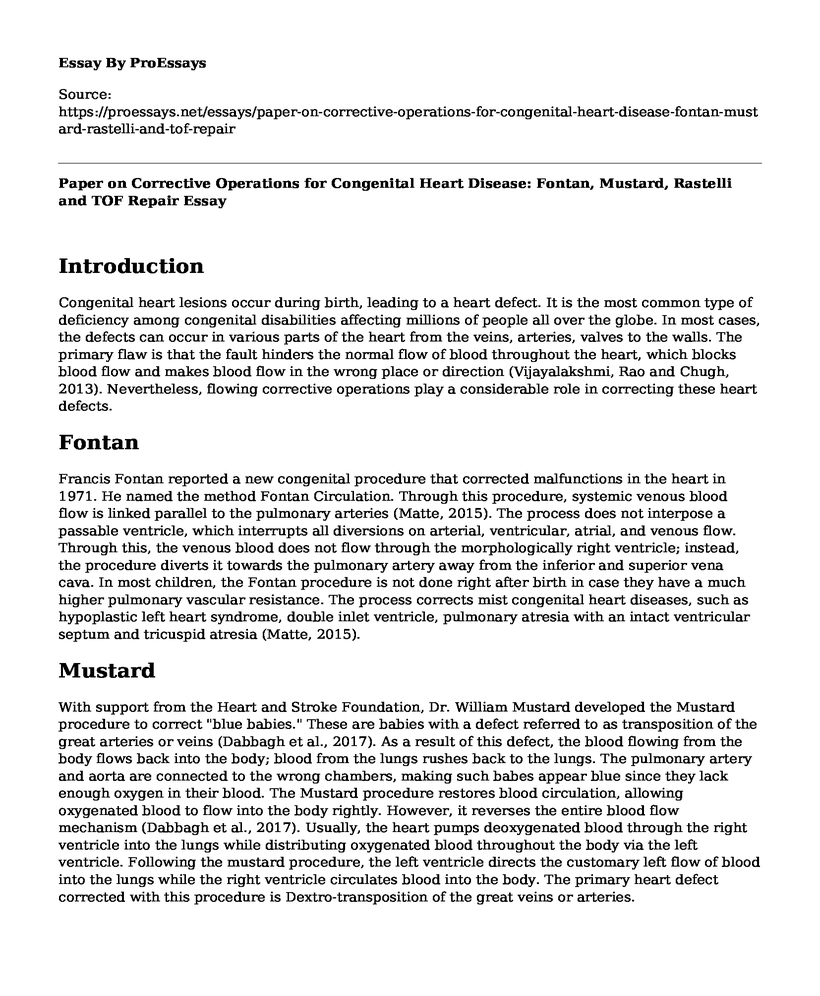Introduction
Congenital heart lesions occur during birth, leading to a heart defect. It is the most common type of deficiency among congenital disabilities affecting millions of people all over the globe. In most cases, the defects can occur in various parts of the heart from the veins, arteries, valves to the walls. The primary flaw is that the fault hinders the normal flow of blood throughout the heart, which blocks blood flow and makes blood flow in the wrong place or direction (Vijayalakshmi, Rao and Chugh, 2013). Nevertheless, flowing corrective operations play a considerable role in correcting these heart defects.
Fontan
Francis Fontan reported a new congenital procedure that corrected malfunctions in the heart in 1971. He named the method Fontan Circulation. Through this procedure, systemic venous blood flow is linked parallel to the pulmonary arteries (Matte, 2015). The process does not interpose a passable ventricle, which interrupts all diversions on arterial, ventricular, atrial, and venous flow. Through this, the venous blood does not flow through the morphologically right ventricle; instead, the procedure diverts it towards the pulmonary artery away from the inferior and superior vena cava. In most children, the Fontan procedure is not done right after birth in case they have a much higher pulmonary vascular resistance. The process corrects mist congenital heart diseases, such as hypoplastic left heart syndrome, double inlet ventricle, pulmonary atresia with an intact ventricular septum and tricuspid atresia (Matte, 2015).
Mustard
With support from the Heart and Stroke Foundation, Dr. William Mustard developed the Mustard procedure to correct "blue babies." These are babies with a defect referred to as transposition of the great arteries or veins (Dabbagh et al., 2017). As a result of this defect, the blood flowing from the body flows back into the body; blood from the lungs rushes back to the lungs. The pulmonary artery and aorta are connected to the wrong chambers, making such babes appear blue since they lack enough oxygen in their blood. The Mustard procedure restores blood circulation, allowing oxygenated blood to flow into the body rightly. However, it reverses the entire blood flow mechanism (Dabbagh et al., 2017). Usually, the heart pumps deoxygenated blood through the right ventricle into the lungs while distributing oxygenated blood throughout the body via the left ventricle. Following the mustard procedure, the left ventricle directs the customary left flow of blood into the lungs while the right ventricle circulates blood into the body. The primary heart defect corrected with this procedure is Dextro-transposition of the great veins or arteries.
Rastelli
An Italian cardiac surgeon and physician, Giancarlo Rastelli, introduced the procedure (Mazur et al., 2013). It plays an essential role in correcting an amalgamation of various congenital heart defects. When conducting the process, a Gore-Tex patch directs the flow of oxygenated blood into the aorta away from the left ventricle (Mazur et al., 2013). Additionally, an expert performs a surgical procedure to close the pulmonary valve. The method then enhances the right ventricle by placing an artificial valve and conduit linking it to the pulmonary bifurcation. The process allows the flow of deoxygenated blood back into the lungs for oxygenation. The heart defects corrected using this procedure include pulmonary stenosis, pulmonary atresia, double outlet right ventricle, right ventricular outflow tract obstruction, ventricular septal defect and transposition of the great arteries or veins (Mazur et al., 2013).
TOF Repair
The tetralogy of Fallot repair corrects four types of congenital heart defects: overriding aorta, right ventricular hypertrophy, pulmonary stenosis and large ventricular septal defect (Wheeler, Wong and Shanley, 2014). Meticulously studying the flaws attests that not enough blood reaches the lungs for oxygen; thus, leading to blood deficient in oxygen flowing into the body. The surgery is an open heart one. TOF repair seeks to improve the flow of oxygenated blood into the body and lungs. It enlarges or exchanges the pulmonary valve and the channel from the right ventricle to the pulmonary artery (Wheeler et al., 2014). Additionally, the surgery closes the VSD to prevent the mixing of blood between the left and right ventricles.
References
Dabbagh, A., In Hernandez, C. A. T., & In Lubin, L. (2017). Congenital heart disease in pediatric and adult patients: Anesthetic and perioperative management
Matte, G. S. (2015). Perfusion for congenital heart surgery: Notes on cardiopulmonary bypass in a complex patient population.
Mazur, W., Siegel, M. J., Miszalski-Jamka, T., & Pelberg, R. (2013). CT Atlas of Adult Congenital Heart Disease [recurso electronico]
Vijayalakshmi, I. B., Rao, P. S., & Chugh, R. (2013). A comprehensive approach to congenital heart diseases. New Delhi: Jaypee Brothers Medical Publishers (P) LTD.
Wheeler, D. S., Wong, H. R., & Shanley, T. P. (2014). Pediatric Critical Care Medicine [recurso electronico]: Volume 4: Peri-operative Care of the Critically Ill or Injured Child.
Cite this page
Paper on Corrective Operations for Congenital Heart Disease: Fontan, Mustard, Rastelli and TOF Repair . (2022, Apr 16). Retrieved from https://proessays.net/essays/paper-on-corrective-operations-for-congenital-heart-disease-fontan-mustard-rastelli-and-tof-repair
If you are the original author of this essay and no longer wish to have it published on the ProEssays website, please click below to request its removal:
- Paper Example on HIV Disclosure Law in Australia
- Impacts of Stigma on Diabetes - Paper Example
- Consequences of Breaking Ethics Rule in Nursing - Essay Sample
- Collaboration and Leadership for Effective Emergency Management - Article Analysis Essay
- Paper Example on Discrimination Against Older Adults: Examining Ageism in Society
- Essay Sample on Expertise in Caring: Nursing Care for Better Health
- Essay Example on Ethics of Randomized Clinical Trials: Arguing for RCTs







